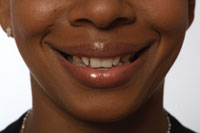The following is a simplified method of constructing a new, improved denture for someone who already has a functional denture or set of dentures. This technique simplifies and reduces the total number of visits that are required. Patients’ acceptance of their new denture is greatly increased, and few adjustments, if any, will be needed. Lab fabrication is more predictable and simplified.
The best candidates for this procedure are patients who are basically happy with their old-but-worn-out denture. Their occluso-vertical dimension should be within a normal range. They should be free of TMJ pain.
TECHNIQUE AND MATERIALS
This procedure utilizes a technique that has been around for a long time—duplicating an existing denture with the Lang Denture Duplicator (Lang Dental Manufacturing Co). Originally, we used this duplicator to construct an inexpensive “get-home” denture with “poured” white acrylic teeth and pink bases. More than 15 years ago, we started duplicating many of our patients’ dentures for use as “custom trays” for the fabrication of their new dentures.
We simply duplicate their existing dentures, remove any over-extensions, border mold as necessary, take a wash, a bite registration, and a shade. We make notes to the lab as to what cosmetic changes we desire. We also include a before photo so the laboratory technician will have a very clear idea of the cosmetic changes we want to make. We give instructions to set up the new teeth on a processed acrylic base plate for a try-in. We like the try-in base plate to be processed to adequately reflect the actual fit of the final prostheses. If the fit at try-in is not adequate, you have one more chances to correct the problem—you can add to the post-dam area or take another wash.
Also, because the lab technician has set up the teeth on this base plate, you can check the cosmetics, the bite, and phonetics at this time (the second visit). The third visit, you deliver the case, relieve any interferences, adjust the bite, and send the usually happy patient home.
CASE REPORT
 |
 |
| Figure 1. Preoperative photo of patient. Note the narrow buccal arches and the “Bucky Beaver” appearance of the central incisors. Our plan was to widen the buccal corridors and provide for a more harmonious cosmetically pleasing smile. | Figure 2. The dental assistant duplicates the patient’s original denture using the Lang Duplicator and inexpensive acrylic and hydrocolloid. |
 |
 |
| Figure 3. The patient’s original upper denture. | Figure 4. The materials used to duplicate the dentures are Jet acrylic in white and pink (Lang), plus a pressure curing pot. |
 |
 |
| Figure 5. The teeth are poured in white acrylic. | Figure 6. The duplicator closed. |
 |
 |
| Figure 7. The original denture and the duplicated upper denture (right side). | Figure 8. The final result at the third visit. The buccal corridors have been filled out to eliminate the dark buccal spaces, and the central incisors have been de-emphasized. The overall appearance of the facial lines has improved. |
The following is a recent case we completed in a total of 3 visits (Figures 1 through 8). Our patient presented with a well-fitting set of dentures, but cosmetically they were deficient, and the patient desired a change.
At the first visit, assuming the dentures have been duplicated during the first visit or in advance, the final impression, bite registration, shade, photographs, etc, plus suggested cosmetic improvements, can be accomplished. (Note: Your auxiliary staff can accomplish the duplicating procedures at the first visit or at a time that is convenient for your patient. With proper training, it takes less than 1 hour to duplicate a set of dentures.) Wash materials can be your material of choice—we have had good results using zinc-oxide Eugenol or Impregum (3M ESPE) materials. Whatever you use, the material must stick to the base plate. The silicones don’t seem to do this.
The major purpose of the second visit is to confirm the fit and cosmetic decisions made on the first visit.
Lastly, the final visit is to deliver the finished product. We have found that patients receiving this service are extremely pleased with the results and require minimal or no postoperative adjustments.
CONCLUSION
Hopefully, this article will help make the fabrication of cosmetically pleasing prostheses for your patients easier and more rewarding.
Dr. Groba has lectured internationally on all aspects of smile makeovers from bleaching to full cosmetic veneers. He is a member of the Houston District Dental Society, the American Dental Association, the Academy of General Dentistry, and the Academy of Cosmetic Dentistry, and has lectured at the University of Texas Dental School in Houston. He can be reached at (281) 482-1275.









